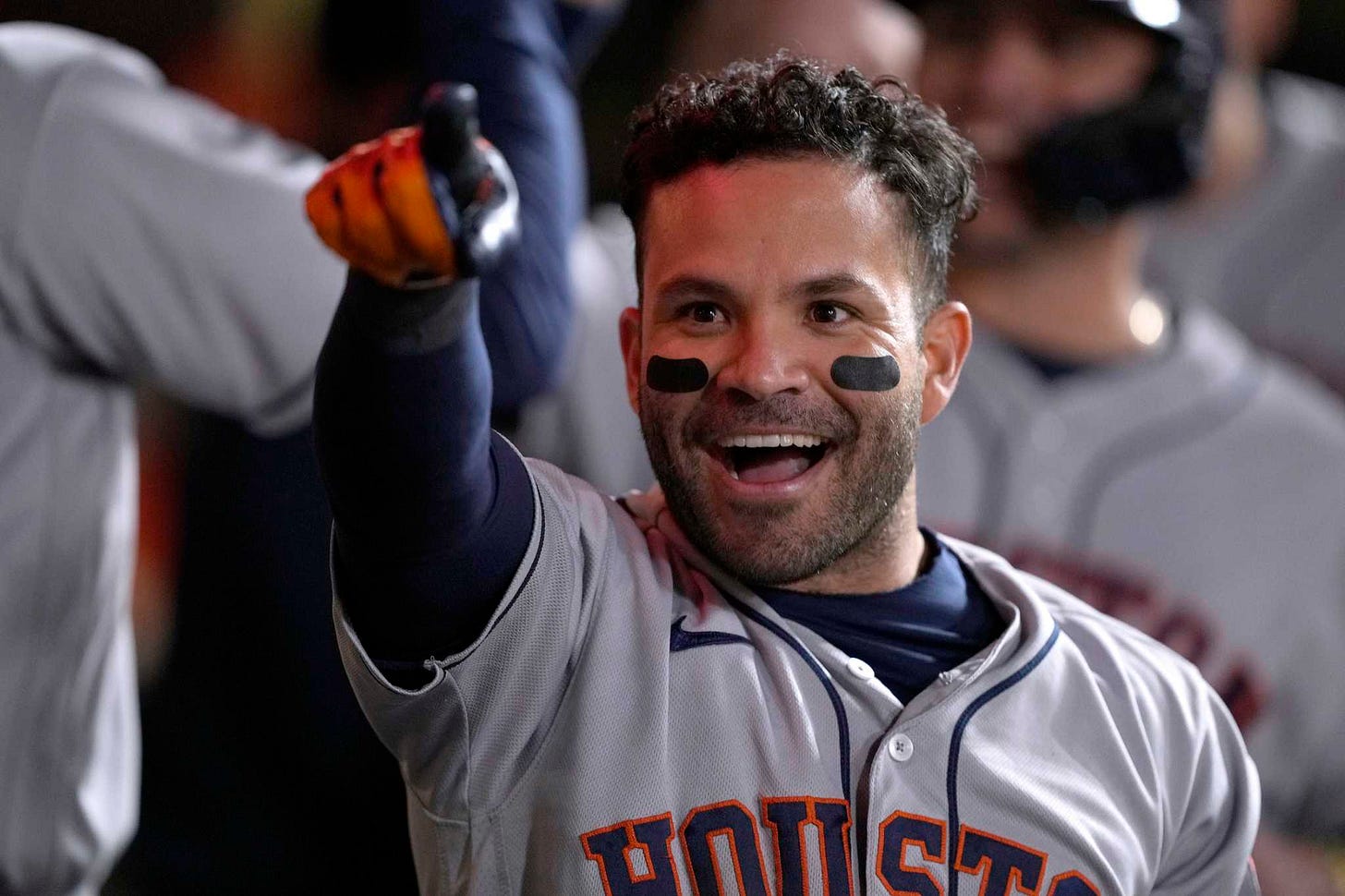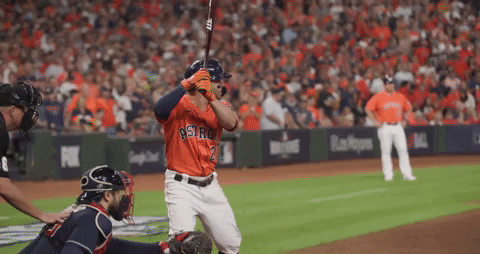Altuve Has Adjusted His Swing and Approach at the Plate: It Has Paid Major Dividends
Jose Altuve is having a great season; he's 4th in the AL in OPS. Why? Altuve made major changes at the plate after his poor 2020 season, and those changes are working.
He’s 4th in the American League in On Base Percentage. He’s 5th in the AL Slugging Percentage. That puts him 4th in the AL in OPS: behind only the handful of best hitters in the league—Aaron Judge, Yordan Alvarez, and Mike Trout. He’s second in the AL in Runs Scored, one of only two over 100 runs scored. He’s 9th in Extra Base Hits and in Win Probability Added. He’s 10th in Total Bases, and, surprisingly for a player with a reputation as a free swinger, 10th in Walks.
Put it all together, and he’s 3rd in the American League in fWAR (decimal points ahead of Yordan Alvarez).
He’s Jose Altuve. And he’s a very good baseball player.
Of course, it will not surprise any Astros fan to hear that Altuve is a very good baseball player. Altuve has amassed 48.3 fWAR over the course of his 12 year career (that puts him 24th—and counting—all time among second basemen) and won the 2017 American League MVP Award on his way to leading the Astros to their first World Series title.
But after 2020, it looked like Jose Altuve may be declining as a baseball player. He slashed .219/.286/.344 for a .629 OPS, over 100 points under the American League average that season of .733.
It is easy to dismiss Altuve’s performance that season as a fluke due to the short season and the weirdness of playing baseball in the heart of the coronavirus pandemic. But Altuve didn’t. After the 2020 season, he made major changes to his swing—raising his launch angle—and his approach—chasing fewer pitches.
Most Astro fans know that Altuve adjusted from a slap hitter to develop more power as he matured as a player. His ability to increase his power was how he moved from a useful hitter in his first few season in the majors to the MVP.
But Altuve’s post-2020 adjustment has been less discussed. In this post, I’ll sketch out the evidence of how Altuve has changed his swing and his approach at the plate. That these changes have paid off are clear when one examines Altuve’s place among the American League offensive leaders this year.
Hitting The Ball In The Air
As I mentioned, most baseball fans know that the biggest change in Jose Altuve’s batting profile over his time in the majors is the growth of his power. In each of his first four seasons in the majors, Altuve hit home runs in the single digits. Starting in 2014, Altuve has been to increase his power (he’s hit double digit home runs every year since then), and thus his productivity.
The graph below shows Altuve’s Isolated Power1 and Hard Hit Percentage for every season of his career. And these two measures move together for most of Altuve's career. Starting in 2014, Altuve started hitting the ball harder, and, as a result, his isolated power went up.
Then in 2020, Altuve slumped, and he hit only 14 extra base hits in 210 plate appearances. His hard hit percentage declined as well, though not as sharply. In 2021 and again in 2022, Altuve raised his isolated power to the 3rd (2021) and 2nd (2022) best of his career. Yet, Altuve did not raise his hard hit percentage. It remained steady at the level he showed in 2020.
After years of their being a tight relationship between Altuve’s hard hit percentage and his isolated power, that relationship evaporated in 2021 and 2022. So how did Altuve raise his isolated power without hitting the ball harder?
He started hitting the ball higher.
The figure below shows Altuve’s average launch angle for each season since 2015. Altuve's launch angle varies little between 2015 and 2020, but there is a clear break going into last season. Altuve increased his launch angle in 2021 and has lifted it even more in 2022.
Altuve has been hitting the ball in the air more. In fact, a lot more. The figure below shows that starting in 2021, Altuve started hitting a lot more fly balls and a lot fewer ground balls.
From his debut season of 2011 to 2020, the share of fly balls and ground balls that Altuve hit was relatively consistent. There are some bumps and wiggles in the data, but Altuve hit the ball on the ground about 45% of the time and in the air about 30% of the time. That shifts in 2021 when Altuve increases his share of fly balls and decreases his share of ground balls.
In general, it is better to hit fly balls than it is to hit ground balls, especially if you hit the ball hard. If you hit a ground ball hard, it might find a seam between the infielders and be a single. Or a double if you get it between a corner infielder and the line. Or it might be hit straight at a fielder, who then throws to first for an out.
But if you hit the ball hard AND you hit it in the air…
What has been remarkable about the decision by Altuve to sell out for more power is that he has not compromised his ability to be a high contact hitter. In fact, he may have enhanced it.
The line graph below shows Altuve’s Contact %—that is, the percentage of time that he makes contact with a pitch when he swings that bat. And you can see that he has maintained a Contact % above the MLB average throughout his career. But his contact rate was declining and moving closer to the MLB average from 2015 through 2020. That abruptly shifted in 2021, as Altuve raised his contact rate from 80% in 2019 to 85% in both 2021 and 2022. Altuve may be trying to launch the ball more, but he’s also about to make contact more.
The benefits of Altuve hitting the ball in the air more are clear. He set his career high with 31 home runs in the 2021 season. He has hit 28 round-trippers this season, despite the league wide home run rate declining.
Fewer Chases, More Walks
Altuve’s swing change has also come with a change in his approach. Altuve has always been a free swinger, and you can see evidence of that in this figure. It measures what Fangraphs calls O-Swing %. It’s the percentage of pitches outside the strike zone that a batter swings at. It might be better thought of as Chase %.
And it shows that Altuve likes to chase pitches. He does so at a rate above the average major league hitter, with the exception of the 2012 season. His chase rate declined as he improved as a player, and then spiked in 2020, which was a big reason for his slump that season. But then, his O-Swing % declined, precipitously in 2021 and then even further in 2022. In fact, this year, for the first time in a decade, his chase rate is below that of the average major leaguer.
Chasing pitches is bad, because even if you do make contact with this pitch, it is less likely to be solid contact. And while Altuve is much better at making contact with pitches off the plate than the average major leaguer,2 he is just like everyone else. He doesn’t hit it as well when he chases. So the improvement in chase rate is leading Altuve to find better pitches to hit.
And the willingness of Altuve to chase fewer pitches has also had another effect—he is walking more. The figure below shows that Altuve’s walk rate has been increasing over his career. In his first few years in the majors, he rarely walked. But in 2016 he increased his walk rate to right around league average. He maintained that level through the 2020 season.
But having adjusted his swing and his approach after the 2020 season, Altuve was able to increase his walk rate even further in the 2021 to 62nd percentile in the majors. This season, Altuve has increased his walk rate even further; he’s at the 85th percentile among all major league hitters.
Altuve’s Adjustments Have Paid Off
The change in Altuve’s swing and approach after his down 2020 season are pretty remarkable. Altuve has increased his launch angle, hitting more fly balls and, as a result, more home runs. He’s been able to to lay off of more pitches outside of the zone, increasing his walk rate to the top tier in the majors. And, despite all of these changes to his swing and approach, Altuve has maintained the skill that got him to the majors—his elite ability to make contact with major league pitches.
The result has been Altuve’s second best season in the majors. He will not win the MVP this season like he did in 2017. Aaron Judge is going to win it, and Shohei Ohtani will finish second.
But Altuve’s improvement is important for several reasons. First, it shows that it is a good idea to bet on elite talent; those who possess it are more likely to figure things about. Altuve has elite contact skills and he has enhanced those skills by making more productive contact—swinging at fewer pitches outside of the strike zone and hitting the ball toward and over then fences when he makes that contact.
Second, it shows that even veteran players can adjust to help themselves. The average baseball player is believed to peak at age 27, which, not coincidentally, was Altuve’s age when won the MVP in 2017. Altuve made these adjustments going into his age 31 season, when he was past his peak years.
Third, it helps explain why the Astros have improved since the unfortunate 2020 season. The Astros were below .500 in 2020 and only made the playoffs that season because baseball expanded the playoffs temporarily due to the pandemic-induced shortened season. But that seasons seems only a blip in the Astros trajectory, as the team has gone back to winning the AL West handily each of the last two seasons. Having Jose Altuve return to being Jose Altuve is a big reason for that.
And fourth, Altuve has tended to hit in the playoffs like he has this season. Over 363 post season at bats, Altuve is slashing .286/.361/.547 for a .907 OPS. And he’s hit 23 postseason homers, which is the 2nd most in MLB history. Having a healthy and productive Jose Altuve at the top of the Astros lineup has worked for this team team before, and I’m willing to bet that it will again this October.
Maybe we’ll see something like this again.
Isolated power is measured by subtracting a player’s batting average from their slugging percentage. It thus “isolates” a player's ability to hit for power from his ability to hit for batting average. It is particular useful for players with high batting averages such as Altuve.
Altuve has made contact with 71.4% of the pitches he’s chased out of the strike zone this season. The MLB average is 63.5%.











